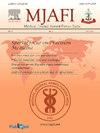phenoxetol和甲醛不同组合对人体尸体组织组织学特征保存的有效性
Q2 Medicine
引用次数: 0
摘要
本文章由计算机程序翻译,如有差异,请以英文原文为准。
Effectiveness of different combinations of phenoxetol and formaldehyde on preservation of histological features in human cadaveric tissues
Background
Fixation preserves the tissues in a close to the life-like state by preventing its autolysis and putrefaction. Formalin has long been considered the close to ideal fixative for histological studies. With the awareness of occupational hazards, a few researchers have tried phenoxetol as a secondary preservative which offered comparable histological results to that of formalin. The adoption of phenoxetol as a non-toxic histological fixative of choice for staining purposes will require a process of validation; hence, the study aimed to see the suitability of different proportions of formalin and phenoxetol which can be used as a histological fixative.
Methods
A few tissue sections (lip, ear lobe, muscle, vessels, and adipose tissue) were taken from a single cadaver before routine formalin-based embalming. The tissues were cut into smaller segments and fixed in 10% formalin, 1% phenoxetol, and in different proportions of 10% formalin and 1% phenoxetol. After the set time of fixation, tissue processing was carried out, and the slides were stained using hematoxylin and eosin (H&E) as well as special stains. The histological features of the tissues were assessed by two observers who were blinded to the fixation process.
Results
Most of the tissues preserved in 1% phenoxetol stained sufficiently well compared to other fixatives (formalin, phenoxetol + formalin). As the study was done using a standardized protocol followed for 10% formalin, few combinations did not work well. Still, the tissues fixed in 1% phenoxetol gave excellent results.
Conclusion
We can conclude that for histological studies, 1% phenoxetol can be used as a short-term primary fixative.
求助全文
通过发布文献求助,成功后即可免费获取论文全文。
去求助
来源期刊

Medical Journal Armed Forces India
Medicine-Medicine (all)
CiteScore
3.40
自引率
0.00%
发文量
206
期刊介绍:
This journal was conceived in 1945 as the Journal of Indian Army Medical Corps. Col DR Thapar was the first Editor who published it on behalf of Lt. Gen Gordon Wilson, the then Director of Medical Services in India. Over the years the journal has achieved various milestones. Presently it is published in Vancouver style, printed on offset, and has a distribution exceeding 5000 per issue. It is published in January, April, July and October each year.
 求助内容:
求助内容: 应助结果提醒方式:
应助结果提醒方式:


